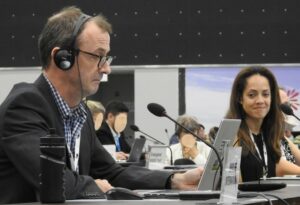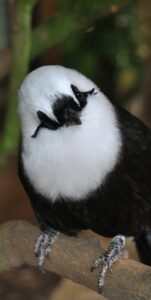
Today at the CITES CoP19 the important doc. 74 was treated this document is so important for Songbirds because it aims to renew the commitment which was made at the previous CITES Conference of the Parties towards supporting research, consulting with experts and convene a workshop for better protection of Songbirds in CITES. As this is completely in alignment with the aims of the EAZA Silent Forest Group and our partners, but unfortunately no activities could be initiated by the CITES secretariat in the interim we strongly support this proposal.
We have prepared for this discussion and a joint intervention on behalf of the partnership was given by Roger Safford from BirdLife International.
The Intervention reads:
“This intervention is on behalf of AZA, BirdLife International, EAZA, IUCN, San Diego Zoo Wildlife Alliance,
Species360, Taronga Conservation Society, TRAFFIC, WCS, WWF, WAZA, ZAA Australasia, and ZSL.
The issue of international songbird trade remains urgent and unresolved with little tangible progress made in taking forward the decisions made at CoP 18.
Songbirds represent more than half of the world’s bird species. They remain gravely underrepresented in CITES, despite their prevalence in international trade, both legal and illegal. This trade is expected to continue at increasing levels, and it is critical to address the knowledge gaps which continue to hamper a true understanding on the scale of this trade.
We therefore fully support CoP19 Doc.74, to renew the commitments from Cop 18 on Songbird Trade and Conservation Management. As a consortium of global organisations who continue to work on this matter, we offer our support in its implementation, to ensure that it is prioritised and momentum is sustained into the next CoP cycle.”

Going forward the EAZA Silent Forest Group pursue some of the following immediate aims in relation to CITES policies:
- Presenting songbird trade research as well as new information resources, including two major reviews mentioned in CoP19 Doc. 74 that can be used for CITES decision making process.
- Advocating for stronger use of CITES as a tool to protect threatened species of Passeriformes from unsustainable and illegal trade and enable data collection and access for stronger evidence-based decisions in the future (links to CoP19 Doc74 – Songbird trade and conservation management)
- Support implementation of CITES Decisions 18.256-259, or the Decisions expected to replace or extend these at COP 19
- Supporting the implementation of the two CoP19 CITES listing proposals for songbirds (White-rumped Shama and Straw-headed Bulbul)
- Develop holistic conservation approaches for the challenges songbird species already protected by CITES face
- Develop species assessments in the view of how CITES listings can support species conservation through data accumulation, regulations, sustainable use initiatives, and enhanced legislation enforcement
